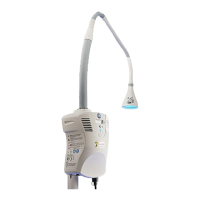61
Chapter 10: Diagnostics and Troubleshooting
ID Symptom Description Possible Causes Actions & Solution
S11
The system generates
low light output (less than
27 µW · cm
-2
· nm
-1
on
average).
Protective cover of
light shade is dirty or
heavily scratched.
Clean the cover or replace the light shade if necessary.
Clean the cover gently using an optical cleaner and a lint-
free wipe. For replacement instructions, refer to section
11.4.
Light pipe is
improperly installed.
Remove the light pipe and re-install it properly. Refer to
section 11.3.
Wrong light meter is
used for light output
measurement.
Make sure that the recommended light meter is used for
light output measurement.
The light shade
is farther than 38
cm (15”) from the
bed surface or not
directly aimed at it.
Focus the therapeutic light such that the spot diameter
is 35.5 cm (14”) or the shade is 38 cm (15”) from the bed
surface, and the light is aiming at the bed surface.
Light pipe is
defective or LED
module is defective
or reached end-of-
life.
Contact service.
S12
The system generates
nonuniform light output
distribution (the lowest to
highest reading ratio is
less than 0.4).
Protective cover of
light shade is dirty or
heavily scratched.
Clean the cover or replace the light shade if necessary
(Refer to section 11.4).
Light pipe is
improperly installed.
Remove the light pipe and re-install it properly.
Light pipe is
defective.
Replace the light pipe.
10.1 Troubleshooting Fuses
1. Access the system fuses as per instructions in section 11.2 to conrm that both fuses are present.
2. Verify the fuse continuity by measuring the fuse resistance using a multimeter.
3. If the fuse is open, try to locate a short circuit or other fault and x it before replacing the fuse.
4. If no short circuits or wiring faults are found, replace the fuse as instructed in section 11.2.

